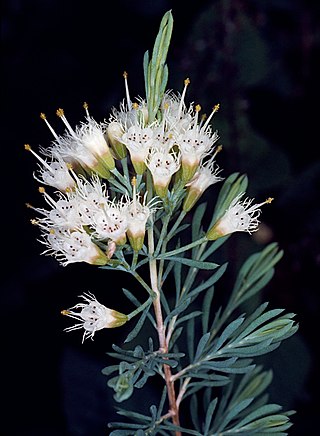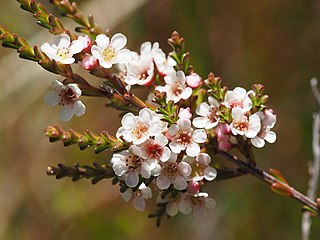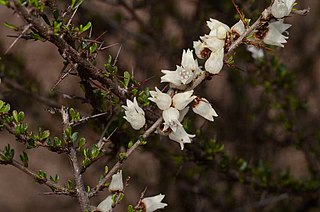Micromyrtus barbata is a species of flowering plant in the family Myrtaceae and is endemic to inland areas of Western Australia. It is a shrub with small, overlapping, narrowly egg-shaped leaves and small white flowers arranged singly in upper leaf axils.
Thryptomene caduca is a species of flowering plant in the family Myrtaceae and is endemic to a small area in the north-west of Western Australia. It is a spreading shrub with crowded egg-shaped leaves with the narrower end towards the base, and pink flowers with five petals and seven to nine stamens.

Homoranthus coracinus is a flowering plant in the family Myrtaceae and is endemic to a small area in Queensland. It is a low, spreading shrub with pointed, narrow, egg-shaped leaves and groups of up to six flowers with black petals. It is only known from a single population in the Ka Ka Mundi part of the Carnarvon National Park.

Homoranthus tropicus is a flowering plant in the family Myrtaceae and is endemic to tropical north Queensland. It is a shrub with curved, club-shaped leaves and white flowers in a corymb-like arrangement on the ends of branchlets.
Triplarina bancroftii is a species of flowering plant in the myrtle family, Myrtaceae and is endemic to a restricted area of Queensland. It is a shrub with egg-shaped or elliptic leaves, flowers with five sepals and five relatively small white petals and sixteen to eighteen stamens.
Triplarina calophylla is a species of flowering plant in the myrtle family, Myrtaceae and is endemic to a restricted area of north Queensland. It is a shrub with egg-shaped leaves with the narrower end towards the base, flowers with five sepals, five white petals and fourteen or fifteen stamens.
Triplarina nitchaga is a species of flowering plant in the myrtle family, Myrtaceae and is endemic to a restricted area of north Queensland. It is a shrub with lance-shaped leaves with the narrower end towards the base, flowers with five sepals, five white petals and seventeen or eighteen stamens.
Triplarina nowraensis, commonly known as Nowra myrtle heath, is a species of flowering plant in the myrtle family, Myrtaceae and is endemic to a restricted area of New South Wales. It is a shrub with egg-shaped to lance-shaped leaves with the narrower end towards the base, flowers with five sepals, five cream-coloured to white petals and fifteen to seventeen stamens.
Triplarina paludosa is a species of flowering plant in the myrtle family, Myrtaceae and is endemic to the Blackdown Tableland in Queensland. It is a shrub with lance-shaped to linear leaves, flowers with five sepals, five white petals and fifteen to eighteen stamens.

Triplarina volcanica is a species of flowering plant in the myrtle family, Myrtaceae and is endemic to Queensland, where it is only found in three mountainous areas. It is a shrub with elliptical to egg-shaped leaves with the narrower end towards the base and flowers with five sepals, five white petals and fourteen to sixteen stamens.

Thryptomene parviflora is a species of flowering plant in the family Myrtaceae and is endemic to Queensland. It is a slender, erect shrub with decussate, linear to egg-shaped leaves with the narrower end towards the base, and flowers with five petals and five stamens arranged singly in leaf axils.

Baeckea omissa is a species of flowering plant in the family Myrtaceae and is endemic to eastern Australia. It is a shrub with egg-shaped to lance-shaped leaves with the narrower end towards the base and white flowers mostly with ten to fifteen stamens.

Leucopogon cuspidatus is a species of flowering plant in the family Ericaceae and is endemic to the central Queensland coast. It is a shrub with densely hairy young branchlets, egg-shaped to lance-shaped leaves with the narrower end towards the base, and white, bell-shaped flowers that are bearded inside.

Cryptandra armata is a flowering plant in the family Rhamnaceae and is endemic to Queensland. It is a shrub with spiny branchlets, spatula-shaped to lance-shaped or egg-shaped leaves with the narrower end towards the base, and creamy-white tube-shaped to bell-shaped flowers.
Cryptandra ciliata is a species of flowering plant in the family Rhamnaceae and is endemic to south-eastern Queensland. It is a shrub with clustered linear leaves and densely-hairy, white, tube-shaped flowers.

Cryptandra longistaminea is a species of flowering plant in the family Rhamnaceae and is endemic to eastern Australia. It is a shrub with many branches, egg-shaped or elliptic to linear leaves, and clusters of white, tube-shaped flowers.
Cryptandra pogonoloba is a species of flowering plant in the family Rhamnaceae and is endemic to south-eastern Queensland. It is a shrub with linear to lance-shaped leaves with the narrower end towards the base, and white to creamy-white, tube-shaped flowers.
Sannantha papillosa is a species in the myrtle family, Myrtaceae and is endemic to north Queensland. It is a shrub with egg-shaped leaves, the narrower end towards the base, and groups of usually 7 white flowers arranged in leaf axils.
Micromyrtus albicans is a species of flowering plant in the myrtle family, Myrtaceae and is endemic to a small area of south-eastern Queensland. It is a slender shrub with overlapping, egg-shaped leaves and small white flowers.
Micromyrtus carinata is a species of flowering plant in the myrtle family, Myrtaceae and is endemic to a small area of south-eastern Queensland. It is a slender shrub with drooping branchlets, overlapping, egg-shaped to lance-shaped leaves and small white flowers arranged singly in leaf axils.







